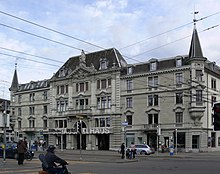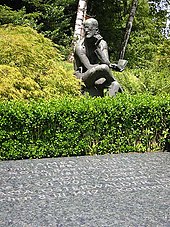James Joyce
Many writers, film-makers, and other artists have been influenced by his stylistic innovations, such as his meticulous attention to detail, use of interior monologue, wordplay, and the radical transformation of traditional plot and character development.
Though most of his adult life was spent abroad, his fictional universe centres on Dublin and is largely populated by characters who closely resemble family members, enemies and friends from his time there.
[20] Joyce began his education in 1888 at Clongowes Wood College, a Jesuit boarding school near Clane, County Kildare, but had to leave in 1891 when his father could no longer pay the fees.
[38][g] In 1901 the National Census of Ireland listed Joyce as a 19-year-old Irish- and English-speaking unmarried student living with his parents, six sisters and three brothers at Royal Terrace (now Inverness Road) in Clontarf, Dublin.
[33] In November, Joyce wrote an article, The Day of the Rabblement, criticising the Irish Literary Theatre for its unwillingness to produce the works of playwrights like Ibsen, Leo Tolstoy, and Gerhart Hauptmann.
[43] Because he mentioned Gabriele D'Annunzio's novel Il fuoco (The Flame),[44] which was on the Roman Catholic list of prohibited books, his college magazine refused to print it.
[47] When the medical school refused to provide a tutoring position to help finance his education, he left Dublin to study medicine in Paris,[48] where he received permission to attend the course for a certificate in physics, chemistry, and biology at the École de Médecine.
Although the London publisher Grant Richards had a contract with Joyce, the printers were unwilling to print passages they found controversial; English law could not protect them if brought to court for circulating indecent language.
[151] Tired of Trieste and discouraged that he could not get a publisher for Dubliners, Joyce found an advertisement for a correspondence clerk in a Roman bank that paid twice his current salary.
[172] Joyce earned additional money by giving a series of lectures at Trieste's Università Popolare on Ireland and the arts,[173] as well as on William Shakespeare's play Hamlet.
[190] In July 1909, Joyce received a year's advance payment from one of his students and returned to Ireland to introduce Giorgio to both sides of the family, his own in Dublin and Nora's in Galway.
[ac] On the advice of Yeats,[212] Pound wrote to Joyce asking if he could include a poem from Chamber Music, "I Hear an Army Charging upon the Land" in the journal Des Imagistes.
[213] After Pound persuaded Dora Marsden to serially publish A Portrait of the Artist as a Young Man in the London literary magazine The Egoist,[214] Joyce's pace of writing increased.
[224] Eventually, Joyce received large regular sums from the editor Harriet Shaw Weaver, who operated The Egoist, and the psychotherapist Edith Rockefeller McCormick, who lived in Zurich studying under Carl Jung.
The company was pitched to the British government as a contribution to the war effort,[252] and mainly staged works by Irish playwrights, such as Oscar Wilde, George Bernard Shaw, and John Millington Synge.
With financial backing from the lawyer John Quinn,[272][af] Margaret Anderson and her co-editor Jane Heap had begun serially publishing it in The Little Review in March 1918[273] but in January and May 1919, two instalments were suppressed as obscene and potentially subversive.
When parts of the novel first came out, some of Joyce's supporters—like Stanislaus, Pound, and Weaver—[290] wrote negatively about it,[291] and it was criticised by writers like Seán Ó Faoláin, Wyndham Lewis, and Rebecca West.
[305] In 1930, Joyce began thinking of establishing a residence in London once more,[306] primarily to ensure that Giorgio, who had just married Helen Fleischmann, would have his inheritance secured under British law.
[308] Joyce stayed in London for at least six months to establish his residency, but abandoned his flat and returned to Paris later in the year when Lucia showed signs of mental illness.
[324] The proposal immediately became controversial, with the Irish Times commenting: " ... it is hard not to suspect that there is a calculating, even mercantile, aspect to contemporary Ireland's relationship to its great writers, whom we are often more keen to 'celebrate', and if possible monetise, than read".
[329][al] He attended socialist meetings and expressed an individualist anarchist view influenced by Benjamin Tucker's philosophy and Oscar Wilde's essay "The Soul of Man Under Socialism".
[334] Joyce's direct engagement in politics was strongest during his time in Trieste, when he submitted newspaper articles, gave lectures, and wrote letters advocating for Ireland's independence from British rule.
[342] Finnegans Wake has been read as a work that investigates the divisive issues of Irish politics,[343] the interrelationship between colonialism and race,[344] and the coercive oppression of nationalism and fascism.
[386] Some hints of the techniques Joyce frequently employed in later works, such as stream of consciousness, interior monologue, and references to a character's psychic reality rather than to his external surroundings, are evident in this novel.
Other poetry Joyce published in his lifetime includes "Gas from a Burner" (1912), Pomes Penyeach (1927), and "Ecce Puer" (written in 1932 to mark the birth of his grandson and the recent death of his father).
[399] This combination of kaleidoscopic writing, reliance on a formal schema to structure the narrative, and exquisite attention to detail represents one of the book's major contributions to the development of 20th-century modernist literature.
[405][aw] The metaphysics of Giordano Bruno of Nola, whom Joyce had read in his youth,[406] plays an important role in Finnegans Wake, as it provides the framework for how the identities of the characters interplay and are transformed.
[407] Giambattista Vico's cyclical view of history—in which civilisation rises from chaos, passes through theocratic, aristocratic, and democratic phases, and then lapses back into chaos—structures the text's narrative,[408] as evidenced by the opening and closing words of the book: Finnegans Wake opens with the words "riverrun, past Eve and Adam's, from swerve of shore to bend of bay, brings us by a commodius vicus of recirculation back to Howth Castle and Environs"[409] and ends "A way a lone a last a loved a long the".
[413] Joyce's innovations extend beyond English literature: his writing has been an inspiration for Latin American writers,[414] and Finnegans Wake has become one of the key texts for French post-structuralism.
[419] A joint venture between the library and University College Dublin, the Museum of Literature Ireland, [420] the majority of whose exhibits are about Joyce and his work, has both a small permanent Joyce-related collection, and borrows from its parent institutions; its displays include "Copy No.


















